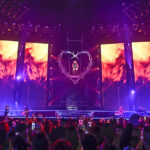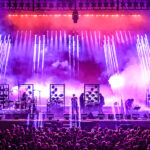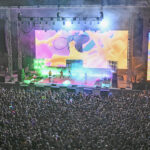The phrase,” A well crafted career,” is often heard regarding the success of someone’s longevity in their particular line of work. This certainly applies to Michael Ledesma. Throughout his career, Mike has possessed a key ingredient underpinning all the elements necessary, that of being present in the moment. For 37 years, he has lit some of the greatest artists of our time, and they, in turn have relied upon him to interpret visually their music and art. Longtime associations with legends Paul Simon, Kenny Loggins and Gloria Estefan are a testimonial to not only his lighting skills but his personality as well.
Given his well-respected name in the business, Ledesma could be employed as much as he possibly wanted, but he based every work decision on how it affected his family. That was always top priority. As Mike prepared to set out on his fourth world tour with Carlos Santana, PLSN sat down with the well know lighting designer to talk.

Santana and the Current Years
Ledesma has sustained friendships with many production people from his early days at Caesars in Lake Tahoe. It was there where he first met Paul “Skip” Rickert, when the tour manager came through with The Little River Band. The two would later work together on Kenny Loggins and a few other tours over the years. In 2012, Rickert reached out to ask if Mike was available to come on board with Santana.
“Carlos plays more dates outside the U.S. than in, and his production people have been doing this big international thing for many years,” says Ledesma. “Therefore, my design ideas needed to encompass what is possible the world over, to overcome the possible lack of lighting, video and rigging.” Ledesma essentially has four simultaneous designs he can morph according to venues. These are the U.S. and Europe full-on rigs, the international set, and the package that supplements Santana’s House of Blues (HOB) residency.

His “basic plan of attack,” as Mike calls it, derives from old-school disciplines he learned in the early stages of his career. A front and overhead general wash of Martin MAC Quantum’s cover all the activities on stage. MAC Vipers deployed in both upstage and downstage trusses do double duty. Equally used for aerial effects and graphics, the upstage fixtures also provide specific focus on individual soloists. The downstage units “pattern up” the wash layer covering the players.
One of Ledesma’s signature looks uses Chroma-Q Color Force 12’s on the downstage floor lip to throw low front light on the band. The hotspot only reaches to their chest. This creates a mysterious under look, further emphasized by tightening the beam from a downstage Viper to a half body shot in a different color. Pairs of ETC 750 Source Four Lekos on the downstage truss are dedicated keys for each musician.
With this basic canvas, Mike tailors his design to the variety of venues Carlos plays. “With Carlos, a set list is merely a suggestion,” laughs Ledesma. “On top of that, he is very fluid within the structures of his songs. Add to the mix his nine-piece band playing at the intensity they play every night and things can get very complicated.

“Some people would say that I program my Hog consoles way more than necessary, but I need that flexibility at my fingertips to represent the band in its best light,” Ledesma continues. “It also allows people like Dave Creigh, Hal Dieter or Dave Chance, who know my style, a greater freedom when they take on operating a tour I have designed.”
The Santana organization has established a well-defined touring schedule, working two weeks a month for 11 months out of the year. For eight weeks each year, they do a residency at the House of Blues (HOB) in Las Vegas, which is booked through 2020. Full production normally travels in four trucks.
“Production manager Mike Kiefer has put together a crew of professionals that are very well versed with international touring,” says Ledesma. He has been using Innovative Concert Lighting (ICL) out of Bakersfield for the last eight years. “They are a small company with great gear, and I can handpick my crew,” he notes. “The guys I have with me on Santana are all crew chiefs. Troy Garcia and Rick Nelson are old Morpheus guys I have known forever. The third guy, Chad Lewis, is an LD in his own right. I stay true to ICL, each year the owner calls me when he is investing in gear to ask what I might be looking for. The account exec. personally handles everything including a proper prep.”
The House of Blues Setup
For the House of Blues residency, Ledesma supplements the house system with gear from the Morpheus shop in Vegas. The package consists of MAC Vipers, the new Ayrton VersaPix™RS and an upstage truss. A local vendor, Blue Planet, supplies the Mega-Lite Medusa fixtures Mike likes. “The Medusa is a great effect light. I equate it to having four small beam type fixtures attached to a Lazy Susan that I can rotate at any speed,” he says. Because of the smaller stage and lower trim, he cuts back to single lekos for specials. “Drew Giancarli, the house LD at HOB, has been a great help tweaking the system these last four years,” Ledesma says.
“The production always carries the KTL ViperBlack upstage center LED video wall so Carlos can look up and see all the video clips, which carry a personal memory he relates to,’ Mike continues. “This brings him great joy.” Off stage left and right are soft good panels with gray scale graphic images on them from Santana’s latest album, Santana IV. These panels contain original artwork of Santana’s himself. When Santana plays the HOB dates, Mike substitutes some Mega-Lite LED panels in their place. All the video clips are played back through an Image Cue media server. Santana’s video director, Bob Higgins, handles I-Mag and content on the video walls separately from Ledesma’s direction.
The video content Mike inputs with his lighting design is based on lumens and color, not image. “I want to complement and interpret Carlos’ music, enhancing the vibe that is going on. To accomplish that, I blend all the old-school design elements by reimaging and applying them to video using color, speed and movement, rather than using all movie files.”
Mike has been a longtime proponent of using pre-viz systems to prep his light show. “I own an ESP system. Before I leave home, I make sure I have s show disk already patched, focused and cloned for every different lighting rig I will use during the run.”

The Early Days
Growing up in San Diego, Ledesma recalls there was always music in the house, because his parents loved music. Being the youngest of four he heard everything his siblings brought home. One of his sisters bought him a Doors album when he was in the 7th grade, “and I thought that was just the coolest thing I’d heard.” This love of music led him to form a band in high school.
A self described “theater geek”, his heavy involvement in high school plays led a teacher to place him in charge as technical director of their school theater. His high school sweetheart (and future wife, Carol) won a scholarship to University of California- Davis, so Mike moved with her to Sacramento in 1978 to attend college. Education went hand in hand with real life experience. Under faculty supervision, students were given the reins to run the services on campus, such as the bus system, coffee houses, book and record stores.

Ledesma landed a job as a student production manager, which entailed presenting shows and concerts at multiple venues on campus, including a small club and theater, as well as a 2,500 seat hall and 8,000 seat arena. “I got the job because of my theater background,” says Ledesma, “and since I had built a little homemade lighting system and put together a small Peavey sound system for my band back in San Diego, I was pretty familiar with the music aspect.
“We really cranked out a lot of shows and earned a reputation for putting on some of the best events at the time,” adds Ledesma. “In the process, I did everything from figuring out how many garbage cans and security we needed, to scheduling labor calls and fulfilling artist riders; everything needed to put on a big budget production in an arena.”
Two years later, Ledesma applied for a position at the newly renovated Caesars Palace Theater in Lake Tahoe. Within a couple of years, he became lighting designer /master electrician and remained on staff until 1990. “I really learned a lot during that time, because I wanted to be the best at everything I did. Tim Ison, in particular, was a mentor who took me under his wing teaching me all about color saturation, intensity and a lot of insight necessary for casino theatrical lighting.”
He also gave Ledesma a very important piece of advice. “‘Be patient, young man,’ he told me, because ‘there are a lot of grown individuals out there who would kill for this opportunity.’”
Beginning Years, Morpheus
Along with the standard Vegas style fare, Caesars saw many ‘70’s and ‘80’s contemporary rock acts. These acts often traveled with their own lighting designers and systems. Ledesma’s enthusiasm to help make these shows the best they could be forged lifelong friendships with some top LDs. He recalls first meeting Patrick Woodroffe, Cher’s lighting designer at the time, and Peter Morse, when he brought Mac Davis in. “There are so many guys I met during those days that I learned from, and wound up working with,” says Ledesma, “Like production manager Harold Jones.” Many of these friendships would shape his career in later years. Ledesma and Jones, for example, worked on multiple projects including Diana Ross, Gloria Estefan, Jon Secada and R. Kelly.
A wide variety of lighting consoles were on the road then; no single control platform was prevalent. Ledesma still vividly remembers, “Watching Steve Cohen run an Alderham board was an amazing lesson in itself.” Caesars used a Kliegl desk as its house console, which led to another fortuitous turn in Ledesma’s career.
When producing shows at the college, Ledesma often rented lights from Morpheus Lights, where he met John Richardson, the original owner. While doing a show at the Sahara one day, Richardson invited Ledesma over to have a look at their newly introduced moving light fixture, the PanaSpot. The console driving the fixtures was a road version of the Kliegl, known as the Performer. After a short demo on the features of the PanaSpot, Ledesma shocked Richardson by intuitively grasping the concept and immediately programming a few looks. He started working as an independent LD for Morpheus in 1983. A stint as the PanaSpot operator on American Bandstand on ABC from 1984-1987 exposed him to lighting for television.
Touring and Moving Lights
In 1984, Ledesma went out on his first tour with Jeffrey Osborne. Michael Keller designed the moving lights on the tour and handed LD reins over to Mike. A year later, he was out with Huey Lewis and the News as the programmer/operator with 80 moving lights. “Those were pretty interesting days,” he notes. During this time, he met Nook Schoenfeld, one of Morpheus’ lighting crew chiefs.
In 1991, Ledesma began his 13-year association with Paul Simon when he became lighting director for an Allen Branton design of Simon’s “Rhythm of the Saints” tour. “I tend to have a lot of steady gigs,” he says. “I started with Kenny Loggins in 1985 and still have the account.”
Brian Higginson, the production manager, chose to use U.K. vendor Meteorlites, with Vari-Lites supplying the movers. Schoenfeld was freelancing by this time, a good friend of Higgy’s, and available. He came on board as the lighting crew chief.
The world tour was out for two years with shows in South Africa, South America, Hong Kong, Japan, all of Europe and China. “That was really the beginning of our working relationship together,” says Ledesma. “Nook could get along with anybody, was very quick on grabbing all different kinds of controllers, and he knew essentially what I was looking for.” In 1996, Ledesma designed Gloria Estefan’s “Evolution” world tour, launching his 20-year association with her.
“This was a huge project, and I really needed a strong individual to jump in and grab this by the reins. By this time, Nook was working as a designer in his own right and out with the Eagles, so he could not join us until about a week into the tour,” says Ledesma, which ran 18 months through South America, Mexico, Japan, Europe, Canada and the U.S. The two went on to a multitude of different projects together, including television, special events, corporate events and theater openings. In 2000, they formed Visual Ventures Design.
“I began working with my longtime clients when the album cycle phenomenon was happening,” says Ledesma. “Record labels usually staggered their artists’ product release, so when Paul was touring behind an album, Gloria or Kenny would be in the studio,” he adds. “I am lucky that clients like Paul Simon, Gloria Estefan and Kenny Loggins have had long careers and stayed with me.”
His partner, Nook, has a slightly different take on it. “I met Mike in 1985 on a Kenny Loggins show, where I saw him do more with conventional fixtures and color changers than most LDs were doing with movers. His multicultural roots bring a lot to the table, especially in his mastery of lighting salsa. Using five bold colors simultaneously in one look is normally a recipe for disaster, yet somehow he pulls it off time after time, and it looks great. He runs his shows with everything at his fingertips and no fear. He also happens to be the funniest LD/impersonator on the planet.”

The Home Front
“I have been involved in so many great events that I would never known had I not chosen this path in high school,” says Ledesma, recalling the Paul Simon Live in Central Park HBO special in 1991, with 350,000 people in attendance, just in the staging area. “What a great thing that was. Allen Branton did the TV bits while Nook and I lit Paul and his band. The lifetime of Paul Simon’s music at Paramount Theatre, was another cool thing we did.” For five weeks, Ladysmith Black Mambazo, Phoebe Snow, Michael Brecker, Steve Gadd, Chris Botti and a cadre of New York’s top musicians supported Paul on stage as he went through his musical career each night.
Mike’s daughter, Danielle, was just three when Mike went on his first tour. “Doing a year-long tour when the kids were little is fine, but as they grew up, it became harder to be a proper parent halfway across the world,” he says. After his son was born, he realized he needed to be closer to home, so he chose to work with smaller tours where he could exercise greater control. The transition took a while, he states, but he did achieve his goal before Mikey reached his teens. “I went for the tasteful cool groups instead of the big tours,” he says.
His son, Mikey, a well-respected backline technician, now works with Ledesma on Santana. “When they were younger, I would bring the kids to work with me on shows as my production assistants,” he continues.” They joked that they were my slaves, but they were paid by me.” For the grand opening of the Miami Symphony Hall, which he and Schoenfeld lit, Danielle was their PA.
“I thank God for this gig and that I was able to seize opportunities at the right time. This business has been nothing but good to me. I have never used it as a place to party or get away. This has always been about furthering my family.”
For more information, visit www.visualventuresdesign.com and www.i-c-l.com.
Carlos Santana Lighting Gear
House of Blues:
House of Blues:
- 1 HES Hog 4 Road Hog
- 1 Hog 3 Expansion Wing
- 18 Martin MAC Auras
- 14 Martin Rush MH3 Beam fixtures
- 10 Martin MAC Viper Pro fixtures
- 10 Martin MAC 700 Profiles
- 8 Ayrton VersaPix RS V2 fixtures
- 6 Ayrton NanoBeam S3 fixtures
- 3 Mega-Lite Medusa 4X5R fixtures
- 14 Color Kinetics Color Blasts
- 2 Atomic 3000 strobes
- 9 Source Four 26°
- 4 8-Lite DWE fixtures
- 2 DF50 hazers
Touring:
- 1 HES Hog 4 console (active)
- 1 Hog 3 Expansion Wing
- 35 Martin MAC Vipers
- 26 Martin MAC Quantum Wash fixtures
- 12 Elation ZFX Wash fixtures
- 16 Martin Atomic 3000 strobes
- 14 Chroma-Q Color Force 12s
- 10 Chroma-Q Color Fours 72s
- 12 Elation Opti QA Pars
- 18 Source Four 19°
- 8 4-Lite DWE fixtures
- 36 LED tiles (12mm, 22” x 22”)
- 1 Image Cue unit
- 1 Image Pro unit
- 4 Martin Pro or MDG Atmosphere hazers


